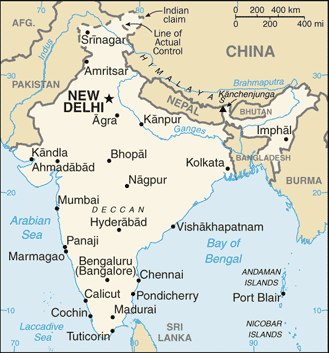With the diversity of a continent within one country, India is one of the great destinations in world travel. Rich in historical heritage, sacred religious sites and natural landscapes, India is a colourful, crowded and chaotic countrythat can be both overwhelming and beguiling. An important centre for some of the world's major religions, India has some of the most sacred Hindu, Buddhist and Sikh sites in the world, in addition to the religious and secular heritage of the Muslim Mughal Empire, seen most notably at the Taj Mahal. The magnificent deserts cities, forts and palaces of Rajasthan are some of India's most popular and recognisable sites, while the legacy of European colonisation is seen in the British-influenced cities and hill stations and the Portugese and Dutch influences in Goa and Kerala. The country has a hugely diverse natural landscape, ranging from the spectacular Himalayan foothills in the north through the deserts of Rajasthan and the sub-tropical south, culminating in the backwaters and beaches of Kerala. In addition, India has some of the best wildlife reserves in Asia, with numerous parks offering the chance to see the famous Bengal tiger and many other species. You could spend years exploring India, so best get started as soon as possible. Explore in depth highlights of India.
| Tours | Unesco WHS | Guidebooks |
|---|---|---|
| groups tours with set departures |
World Heritage Sites | country, regions and cities |
| Time zone: | GMT +5.5 (Indian standard time) | Daylight savings: None |
|---|
| Main languages: | English, Hindi |
|---|
| Other languages: | Assamese, Bengali, Gujarati, Kannada, Kashmiri, Malayalam, Marathi, Oriya, Punjabi, Sanskrit, Sindhi, Tamil, Telugu, Urdu |
|---|
| Currency: |
Indian rupees (INR) €1 = Rs.74.48, $1 = Rs.66.75, £1 = Rs.88.77 (rates as of Sep 2016) |
|---|
| Internet Domain: | .in | International Dialling Code: 91 |
|---|
For help planning your trip to India including visas, vaccinations, currency exchange, flights, accomodation and insurance, see our India trip planning page.




Further information on India
Discover more about India - the country's geogrpahy and natural features, an assessment of its status on freedom and rights and data on the country's population and economy.
Geography & Natural Features
Total area: 3,287,590 sq km (314,400 sq km under water)
Coastline: 7,000 km (Arabian Sea, Bay of Bengal)
Neighbours (border lengths): Bangladesh (4,053km), Bhutan (605km), Burma (1,463km), China (3,380km), Nepal (1,690km), Pakistan (2,912km)
Climate: Climate varies from tropical monsoon in the south, desert in the west and temperate in the north. The monsoon brings steady rains from July to September in the north, extending to between May and November in the south. The cool season follows until February before the heat (it can pass 40C in most areas) and humidity of the hot season begins.
Highest mountain: Kanchenjunga (8,598m)
Freedom & Rights
Summary status and rankings for India from classifications of different organisations measuring political and economic freedom, democracy and civil rights. See more details of these rankings.
| Index | Status | Rank | |
|---|---|---|---|
 | Freedom in the World | Free | - |
 | Democracy Index | Flawed democracy | 27/167 |
 | Economic Freedom | Mostly Unfree | 128/179 |
 | Press Freedom | Difficult situation | 134/179 |
 | ILGA LGBT rights | No rights | - |
 | Corruption Perceptions | Medium corruption | 85/174 |
| Overall Ranking: | 101/195 | ||
Other Data & Links
Full name: Republic of India Status: Independent Country
Population: 1,236,344,631 (rank: 2/196) Density: 376 people/sq km (rank: 20/196)
Ethnic groups: Indo-Aryan 72%, Dravidian 25%, Mongoloid and other 3% (2000)
Religions: Hindu 80.5%, Muslim 13.4%, Christian 2.3%, Sikh 1.9%, other 1.8%, unspecified 0.1% (2001 census)
GDP (PPP): $4962 billion GDP per capita: $4,000 (rank: 139/195)
Information derived from the CIA World Factbook. Other country profiles: BBC News.




















